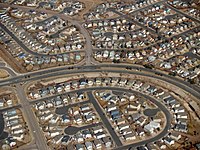
Photo from wikipedia
Abstract The effects of the built environment (BE) on modes of transport have been extensively evaluated in the literature with a primary focus on the neighborhood-level BE. Moreover, it has… Click to show full abstract
Abstract The effects of the built environment (BE) on modes of transport have been extensively evaluated in the literature with a primary focus on the neighborhood-level BE. Moreover, it has been revealed that transportation modes are associated with an individual’s life choices and the resulting quality of life (QoL). However, the effects of the BE on the transportation, which in turn affects the QoL, remain largely unknown. This is especially true considering that the BE can be evaluated at different spatial scales, which further involves both observed and unobserved clustering effects. Based on data from 8,862 respondents living in 97 Chinese cities (collected in 2014), this study builds a generalized structural equation model (GSEM) to explore the complex relationships between both neighborhood- and city-level BE attributes, active commuting, body mass index (BMI), and life satisfaction within a unified analysis framework. The results show that: (1) GSEM significantly outperforms the conventional structural equation model; (2) life satisfaction is related to both active commuting modes and BMI, while the active commuting time is related to BMI; and (3) the city-level BE has a much stronger relevance to active commuting time, BMI, and life satisfaction, but a weaker relevance to active commuting modes, than the neighborhood-level BE.
Journal Title: Travel behaviour and society
Year Published: 2020
Link to full text (if available)
Share on Social Media: Sign Up to like & get
recommendations!